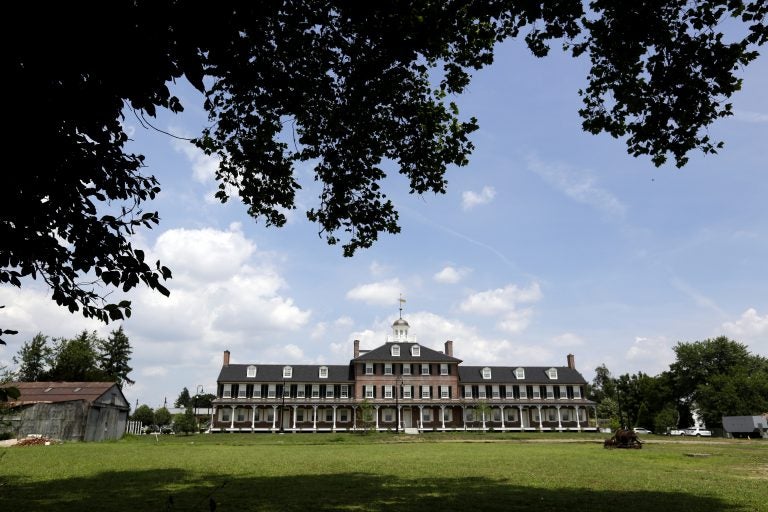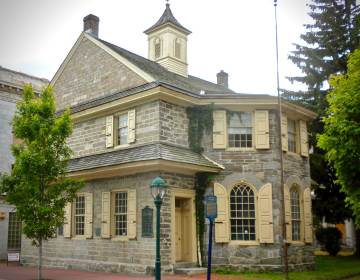Tiny suburban Philly township saves, transforms historic quarantine station
For Tinicum Township, renovating the Lazaretto Quarantine Station was part of a broader plan to draw visitors to the community.

This July 10, 2019 photo shows the refurbished Lazaretto Quarantine Station in Essington, Pa. (Jacqueline Larma/AP Photo)
A tiny community near Philadelphia that managed to save the oldest surviving quarantine station in the Western Hemisphere from the wrecking ball is now transforming the 18th-century structure into township offices.
For Tinicum Township, renovating the Lazaretto Quarantine Station was part of a broader plan to draw visitors to the community, to connect it to other historic waterfront sites and create a destination for both locals and tourists. For historians, saving the Lazaretto offers a chance to tell stories of immigration and public health in America’s early days.
Built in 1799, the quarantine station protected the Port of Philadelphia against the introduction of diseases that could lead to epidemics for nearly a century.
“It’s part of American history that we never learn about,” said David Barnes, a University of Pennsylvania professor who is writing a history of the building. “It gives us entry to a lost world, and into the hidden story of how our country came to be and grow, how it accommodated immigrants and dealt with disasters.”
The tiny township of 4,000 people is bordered by the Philadelphia International Airport, the Delaware River and a nature preserve, which together create dichotomies: wildlife and roads, modernity and history and airport noise and bucolic tranquility. The township was the first European settlement in Pennsylvania, founded by the Swedes in 1643, but today, 70% of the airport sits within the township’s boundaries. It’s a place where an index finger pointing to the sky is the locals’ universal sign for “let’s wait for the plane to pass over and then we can continue our conversation.”
The Lazaretto’s proximity to the airport almost led to its downfall. In the early 2000s, the owner of the site — who had been using the property as a boat marina and repair business — decided to sell the land to a developer. The plan was to raze the building to make way for a parking lot serving the airport.
But township officials scrambled to get grants to buy the land and save the facility. A later settlement with the airport has provided a steady stream of income to improve the township, according to township board president Patrick McCarthy.
“We sat down as a board of commissioners and said, ‘Where do we start with the revitalization of our township?’ And we all agreed, ‘Let’s start with the Lazaretto and move forward from there,'” said Tinicum Township Manager David Scheiber.
The stately, red brick hospital was built by the city’s board of health during the yellow fever epidemic in the late 1700s. During “quarantine season,” from about June to October, every ship bound for Philadelphia would have to stop at the station to have cargo and passengers inspected, Barnes said.
The survival rate for patients was close to 90%, even for those suffering from yellow fever and typhus, which had very high mortality rates in the general population. Barnes said the recovery rates at the Lazaretto boiled down to good nursing care: adequate food and drink, clean clothing, clean bedding and alleviation of symptoms that helped patients heal.
The Lazaretto closed as a hospital in 1890 but then served as a resort and seaplane base before the start of World War I. Seaplanes still land there today.
In addition to the township offices and police station, the 15,700-square-foot (1,460-square-meter) building has gallery space, event rental space and other offices available for rent. The Lazaretto Preservation Association says it envisions exhibits on immigration and public health, as well as kayak and boat rentals, tours and maybe a beer garden or cafe.
“It draws everybody that comes to town to the waterfront and shows what we have to offer,” said Herbert MacCombie, Tinicum’s building official who has worked on the project since the early 2000s. The new township offices are slated to open in September.
For Barnes, the professor, the site’s history makes it alluring on its own.
“To me it is endlessly dramatic, tragic and also inspiring,” he said.
WHYY is your source for fact-based, in-depth journalism and information. As a nonprofit organization, we rely on financial support from readers like you. Please give today.




